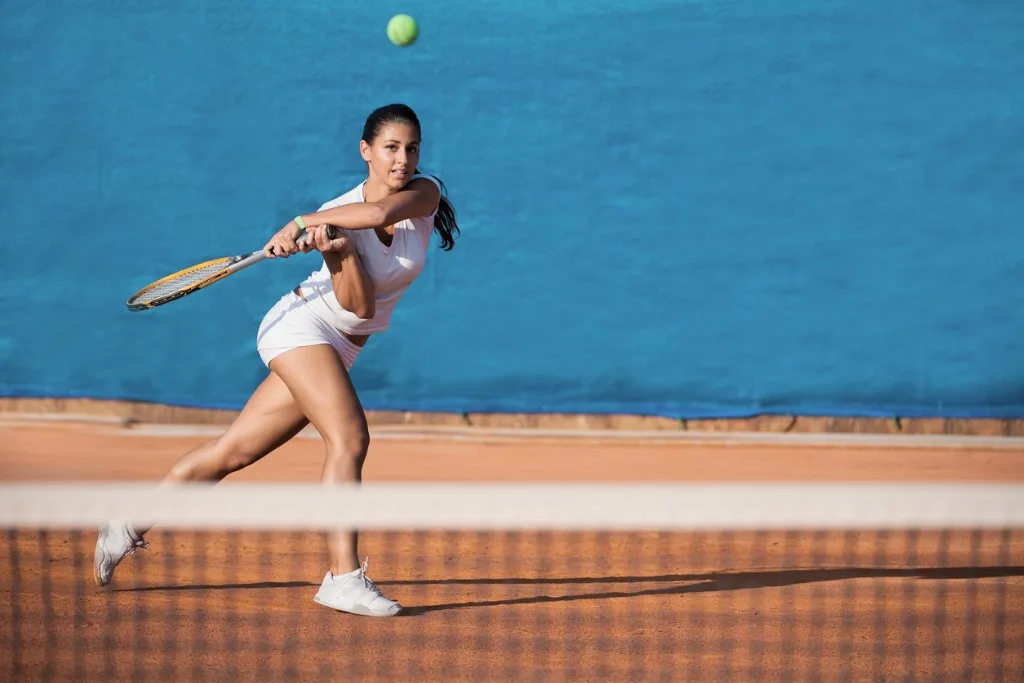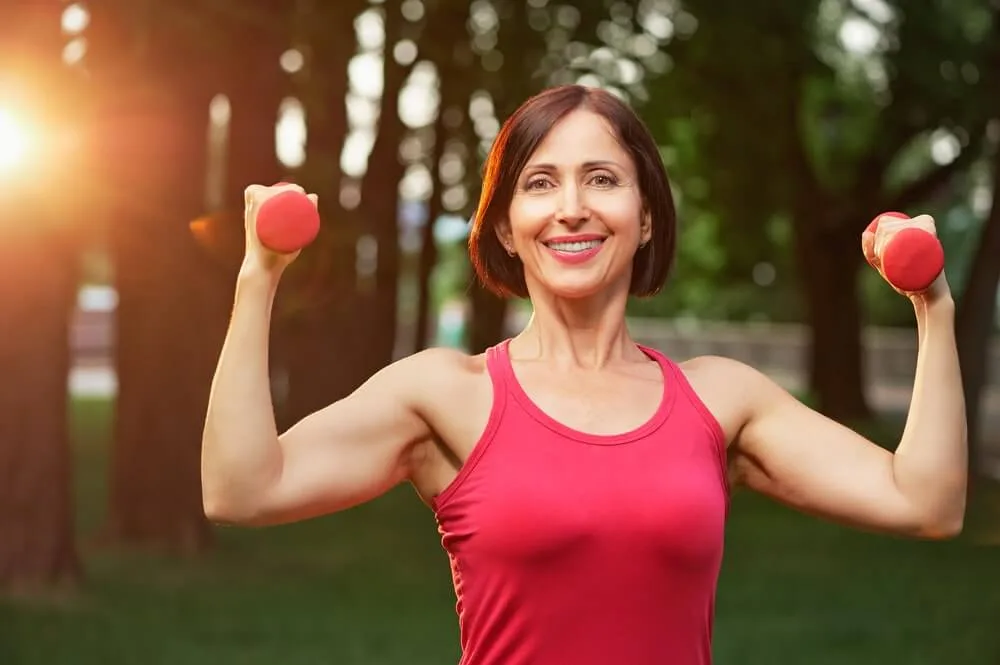Is Pilates good for tennis? Thanks to the likes of Andy Murray and Serena Williams, the benefits of Pilates for tennis players are now well-known.
Committing to regular Pilates sessions helps Williams, Murray and many other players with their post-match recovery and with injury prevention. According to reports, taking up Pilates has even improved Murray’s mindset both on and off the court!
But you don’t have to be a tennis pro to use Pilates to refine aspects of your game. In fact, even if you only play tennis for fun or to keep fit, Pilates classes can still be a great way to enhance your experience of the sport.
Plus, regardless of the level of play, all players are at risk of suffering from game-related niggles. However, strengthening and mobilising your body in Pilates can help you avoid these.
Quick Summary
- With Wimbledon upon us, our thoughts turn to strawberries and cream, long summer evenings and, of course, tennis! If you are feeling inspired by this year’s crop of talented athletes and you think your body could use some extra help to get you tennis fit, Pilates could be just the thing you need to give you an edge.
- Pilates is brilliant for all over body strength and flexibility, as well as spinal mobility. This makes it not only perfect for getting you fit and strong for play, but also for balancing your body in order to reduce the risk of injury.
- If you are recovering from illness or injury it is a brilliant way to gradually build strength and endurance.
- And finally, it is a fantastic complement to your other training, such as cardiovascular work, as part of a well rounded tennis fit programme.
How can Pilates exercises benefit tennis players?
As a method designed to mobilise and strengthen the body in all directions, and create an even musculature, Pilates is the perfect choice for tennis players looking to avoid injury.
But that is not its only benefit, as the likes of Serena Williams and Andy Murray can testify.
Pilates is brilliant for enhancing sports performance.
For these reasons, whether you are a pro and recreational player, you should think about adding in Pilates to your training. Ideally this is with a clinical instructor in a 1-2-1 environment.
What do the experts say?
With this in mind – and with Wimbledon in full swing – we sat down to chat with our resident expert Louise Aylwin, a Physiotherapist trained in rehab Pilates, about why Pilates is so beneficial for tennis players.
 Louise has worked as a sports Physiotherapist for a range of elite sportsmen and women. These include players on the ATP tennis tour and the WTA tennis tournament in Japan.
Louise has worked as a sports Physiotherapist for a range of elite sportsmen and women. These include players on the ATP tennis tour and the WTA tennis tournament in Japan.
Louise, tell us about your personal experience of tennis and Pilates?
I’ve been working in tennis for 20 years and am a keen recreational tennis player myself. I regularly work with professional tennis players who find Pilates an invaluable part of their training.
Pat Cash (the former Wimbledon champion) is also an associate of mine. He is a big advocate of Pilates for tennis players and believes in the physical benefits of it for players of all standards. Pat also regularly practices Pilates for rehab himself.
I’ve seen firsthand how Pilates not only helps reduce the number of injuries tennis players suffer, but can also improve their movement and therefore their game.
Q. So how exactly does Pilates improve a tennis player’s game?
A. Tennis is a high-speed, high-impact and power-based sport.
It requires rotation and extension of the spine and creates stress on the shoulders, knees and hips.
The nature of tennis means that people who play it regularly often have imbalances through their joints and muscles.
Pilates helps practitioners to develop balanced muscles. This makes it a great way to strengthen the body uniformly, as well as correct muscular weaknesses and stabilise any imbalances created through the game.
Q. What specific aspects of Pilates help improve tennis?
A. Much of the power in tennis comes from rotation and extension of the spine.
To produce these movements you need a mixture of strength and flexibility.
Pilates helps loosen tight muscles in the chest, shoulders and upper back. At the same time, it also strengthens important muscles, like those responsible for rotation and for protecting the spine. All of this helps a player generate more power through their strokes.
During a tennis match you are often trying to return a ball from an imperfect position, such as stretching forwards or sideways. To add to the challenge, you usually have to perform these movements when off-balance.
This is where Pilates comes in. Because Pilates focuses on developing strength in those deep stabilising muscles, as well as the muscles of the trunk.
Why is this beneficial? Being off-balance and trying to hit a ball can result in injury. But having strong muscles at the centre of your body helps to reduce the risk of injury and allows you to recover your balance faster. This means that players who practise Pilates a tactical advantage.
Pilates also helps improve flexibility in your lower back and hips. This greater range of movement allows players to, for example, get down low for hard to reach drop-shots or up higher to reach challenging lob shots.
5 Pilates exercises for tennis players
These exercises are designed to improve spinal mobility. They’ll also help to mobilise your shoulders and strengthen your back, abdominals and obliques – areas involved in creating a powerful tennis racket swing.
1. Thread the needle
Benefits: Improves your spine rotation and shoulder flexibility.
How to: Come on to all fours with your hands under your shoulders, your knees under your hips.
Next, take your weight into your right hand. Then take your left hand and thread it, palm facing up, through the space between your right thigh and hand.
Keep your hips still and level to isolate the movement to your upper spine.
Return to all fours before repeating it on the other side.
Repeat 3-5 times on each side.
Related reading: How to do the thread the needle stretch
2. Book Opening
Benefits: Improved spine rotation and stretches your chest.
How to: Come into a side-lying position with your arms together in a straight line and resting on the mat. If you need to, prop your head up with a small pillow or folded towel.
Next, take a deep breath to prepare and then exhale with an open mouth as you open one arm up towards the ceiling and start to twist your spine.
Continue to move your arm in an arc until it rest on the mat next to you, remembering to turn your head as you move.
Keep your knees stacked throughout this movement. This should help you access the top part of your spine.
Reduce your range of movement (e.g. don’t let your arm come all the way to the ground) if you get any lower back pain. This exercise is designed to mobilise your upper spine and you should not be feeling it in your lower back.
Repeat 3 times on each side.
3. Criss Cross
Benefits: Better abdominal and oblique strength and torso rotation.
How to: With your hands behind your head and legs in table top, curl your upper body up until your shoulder blades are off the mat. This mirrors the starting position of the Pilates Hundred exercise.
Next, rotate your upper body by bringing your right elbow to the opposite knee. Extend and straighten your right leg as you do so. Then repeat these instructions on the other side.
Remember, this a dynamic move, so keep up the tempo by swapping between sides quickly. Also, keep your head heavy in your hands to avoiding straining your neck.
Repeat 6-10 times on each side focusing on keeping good form throughout.
4. Mermaid
Benefits: Improved spine mobility into lateral flexion (side-bending).
How to: Come into a “z-sit” position (pictured here) to start, with your right knee in front and left leg bent at your side. If that is uncomfortable, prop your hips up on a block or sit on a chair.
Next, place your right hand on the mat for support and allow your left arm to float up and over in an arc. Allow your spine to bend with it as you find a stretch in the left side of your body.
As you do so, imagine a pane of glass behind your spine. The back of your head should be resting against it and not jutting forward.
Repeat 3-5 repetitions and then move on to the other side.
5. Dart
Benefits: Stronger back-extension muscles. Improved shoulder mobility.
How to: Lie on your stomach with your arms down by your side. Your forehead can rest on a small pillow or folded towel.
Inhale and lengthen the crown of the head away from your shoulders.
Now, on an exhale, reach your hands towards your toes and allow your arms to lift off the ground. As you do so, allow your upper back to curl and lift slightly off the mat but keep your lower ribs in contact with the mat. To protect your lower back, engage your abdominals throughout and press your pubic bone into the mat.
Pause and inhale at the top of the movement, deepening the curl of the upper back if that feels comfortable. Exhale to lower back to the starting position. Remember not to look up as you lift your spine and instead keep the back of the neck long and your gaze towards your mat.
This shouldn’t hurt your lower back. If it does, focus on creating length through the spine even as you curl your spine. You can also try placing your hands on the mat to support your upper body during the exercise.
Repeat this exercise 3 times.
This exercise isn’t suitable for people with acute stenosis or acute facet syndrome.
How to get fit for tennis!
Pilates is a great way of getting fit at home, since it requires little space and can be done with very little equipment. However, it is not the only thing that you will need to get fit for tennis.
Performing a full body programme which focuses on strength, endurance and your core will have a greater effect in keeping you fit to play tennis.
Tennis uses all the components of fitness;
- Strength
- Power
- Agility
- Co-ordination
- Balance
- Flexibility
- Speed
- Endurance
It can be confusing as to how and when to focus on a specific area of fitness.
Cardiovascular exercise for tennis
Tennis uses short (anaerobic) explosive movement patterns repeated over longer periods of time. This means your training should reflect this!
This means getting your heart and lungs working! For the cardiovascular fitness required in an average game, you can consider getting on your bike, running, skipping (great for foot work), jogging or even sprinting on the spot!
Recommendations for maintaining cardiovascular fitness does depend on your current fitness level. Start by working up to 30 minutes three days per week. If this is easy for you, you can do a run or bike 20-60 minutes 5-7 days per week. However, make sure to mix this up so you are not just doing the same thing all the time!
Full-body exercises maximise efficiency in training for tennis and High Intensity Interval Training (HIIT) programmes can offer a specific form of exercise which complements normal match play.
As with a HIIT circuit, you can make your cardiovascular sessions interval based for specificity as well. For example, if you’re using a bike or running for 30 minutes within that time do some short sprints at a moderate or high intensity pace to reflect the bursts of activity required for tennis. This can be anywhere from 15-45 seconds followed by a slower pace in order to recover. Then repeat this throughout your session.
Returning to tennis after a break
It is often time away from the court, either due to rest or injury, that can put you at risk of injuries like Achilles tendon problems or lateral epicondylitis (tennis elbow). These happen because of a sudden increases in load. Like starting tennis at full speed after a long break!
If you have had a long time away from your sport, then it ist time to focus on improving your basic fitness and addressing any imbalances or weaknesses you may have developed along the way.
The aim of Pilates, or any kind of additional exercise at home, is not only to maintain and improve our basic fitness, but also to reduce potential injury and help your mental health.
Like all sports, tennis is a game that puts distinct stresses on the body. It requires sudden stops and starts, muscle extensions, rotation and impact. All of these combined can contribute toback pain – or spinal injury. As with golf, the repetitive nature of the sport and its one-sidedness, causes further problems by building up some muscles and neglecting others. This can lead to muscular imbalances which further puts you at risk of injury.
Tennis places huge demands on our spine. For example, forehand and backhand shots require a large amount of rotation in the spine. The pressures created increase even more in the serve. During this, your spine has to both rotate and extend – almost to end range – as a ball is hit with great force.
When it comes to lower back injuries, a stiff mid or upper spine (the thoracic spine) is often to blame. This part of the spine is responsible for rotation, flexion and extension – movements vital for all the different tennis strokes. When there is a lack of mobility in this part of the spine, your lower (lumbar) spine has to compensate for it by acting in a way it’s not designed to for example, with excessive rotation or extension.
This means that improving mobility of your thoracic spine can help you reduce stress on the lower back. Doing so will also help improve your power production in forehand and backhand strokes. A win all around!
Because of this, it makes sense for you to work on your thoracic mobility – which is where Pilates exercises can come in and are a perfect solution!
Should you do you do a warm-up for tennis?
Maybe you have an ‘old-school’ approach of going on court stretching of your calves and quads? It is important to recognise that ‘stretching’ for injury prevention is lacks good research to support it. Flexibility is one of the main components of fitness, but we have to make sure we get this flexibility in an effective way. Overall, the research suggests it does not reduce risk of injury, improve performance or help influence pain levels.
So what do we do instead?!
The best way to think of a warm-up in tennis, like most other sports, is to make sure you increase your heart rate, allow your blood pressure to adapt and increase your body temperature.
You can do this on a bike, with a light jog, or even better, performing movements which you will shortly be performing during play.
For example, gradually increasing the intensity and speed of lunging forward, back, and side to side, squats, court jogs, doing some jumps and hops and gently swinging of the racket high and low will get you primed and ready for your game!
This can all be practised at home and is a great way of getting your body ready for your return to court.
Want to see how we can help your tennis game further? Try a 1:1 session in person or online so that we can develop a program specific for your needs.
Talk to us about how Pilates might help with your tennis. You can find us at our Pilates studio in Islington or any of our studios (see our Kensington Pilates studio or Complete Pilates City of London) for more information, please get in touch online or contact us on 0203 764 5668.
Get in touch with us via email or contact us on 0203 764 5668 for further information.
Education is key:
These blogs are designed to give information to everyone, however, it is important to remember that everyone is different! If you have not seen one of our therapists and have any questions about injuries, what you have read or whether this may be useful to you, please just ask. We are more than happy to help anyone and point you in the right direction. Our biggest belief is that education is key. The more you understand about your injury, illness and movement, the more you are likely to improve.




